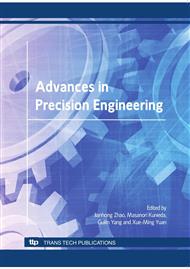p.417
p.422
p.427
p.432
p.437
p.442
p.447
p.452
p.456
Investigation of Process Parameters in Superplastic Forming of Mechanical Pre-Formed Sheet by FEM
Abstract:
Conventional superplastic forming has been applied in automotive and aerospace industries for a few decades. Recently, superplastic forming combined with mechanical pre-forming process has been reported to be capable of forming non-superplastic AA5083 at 400 °C to a surface expansion of 200 % [1]. In this paper, finite element modeling (FEM) was used to develop the combined forming process by using the non-superplastic material AA5083-O. The simulation follows the experimental sequence and was divided into two phases (mechanical pre-forming and superplastic forming). A conventional creep equation based on tensile test data was adopted as a material model for the simulation. The pressure cycle and forming time was simulated according to the actual process route. The thickness distributions obtained from simulation validated the capability of the model to be used for this case. The influence of different parameters, such as holder force, friction, and punch depth was investigated by comparing the final sheet thickness and level of material draw-in. It was found that the punch depth played a significant effect on the uniformity of thickness distribution, from which a more uniform formed part can be obtained by using the punch with higher depth during mechanical pre-forming phase.
Info:
Periodical:
Pages:
437-441
Citation:
Online since:
September 2010
Price:
Сopyright:
© 2010 Trans Tech Publications Ltd. All Rights Reserved
Share:
Citation:


